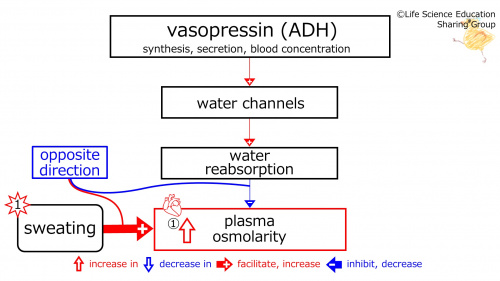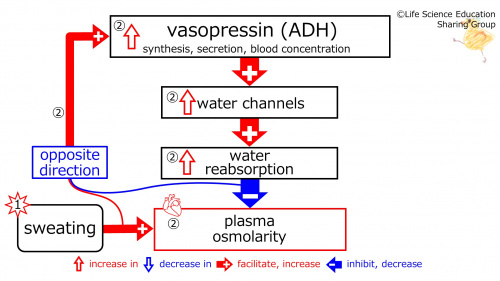「Endocrinology/VasopressinADH/ControlToSweating/basic」の版間の差分
編集の要約なし |
細 (Admin がページ「SHolroydAtWeilCornellMedQatar/Endocrinology/VasopressinADH/ControlToSweating/basic」を「Endocrinology/VasopressinADH/ControlToSweating/basic」に、リダイレクトを残さずに移動しました) |
(相違点なし)
| |
2024年4月1日 (月) 09:56時点における版
| With sweating, the (blue→red) negative feedback increases (the synthesis, secretion, and blood concentration of) vasopressin (anti-diuretic hormone, ADH). |
① Sweating increases plasma osmolarity (concentrated, hypertonic), and water reabsorption (through the water channels, which are increased by vasopressin, ADH) decreases plasma osmolarity. These effects are in the opposite direction (blue).
② Since these effects are in the opposite direction (blue), negative feedback increases (red) (the synthesis, secretion, and blood concentration of) vasopressin (anti-diuretic hormone, ADH). This increases the number of water channels and the water reabsorption. The plasma osmolarity-decreasing effect of the water reabsorption becomes stronger. This will lead to a reverse in the increased plasma osmolarity (concentrated, hypertonic) produced by sweating, decreasing it towards normal (baseline, isotonic) osmolarity.
Challenge Quiz
Sweating increases decreases plasma osmolarity, and water reabsorption (through the water channels, which are increased by vasopressin, ADH) increases decreases plasma osmolarity. Since these effects are in the same opposite direction, negative feedback increases decreases (the synthesis, secretion, and blood concentration of) vasopressin (anti-diuretic hormone, ADH).


